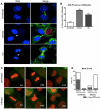Chlamydial infection induces host cytokinesis failure at abscission
- PMID: 22646503
- PMCID: PMC3443326
- DOI: 10.1111/j.1462-5822.2012.01820.x
Chlamydial infection induces host cytokinesis failure at abscission
Abstract
Chlamydia trachomatis is an obligate intracellular bacteria and the infectious agent responsible for the sexually transmitted disease Chlamydia. Infection with Chlamydia can lead to serious health sequelae such as pelvic inflammatory disease and reproductive tract scarring contributing to infertility and ectopic pregnancies. Additionally, chlamydial infections have been epidemiologically linked to cervical cancer in patients with a prior human papilomavirus (HPV) infection. Chlamydial infection of cultured cells causes multinucleation, a potential pathway for chromosomal instability. Two mechanisms that are known to initiate multinucleation are cell fusion and cytokinesis failure. This study demonstrates that multinucleation of the host cell by Chlamydia is entirely due to cytokinesis failure. Moreover, cytokinesis failure is due in part to the chlamydial effector CPAF acting as an anaphase promoting complex mimic causing cells to exit mitosis with unaligned and unattached chromosomes. These lagging and missegregated chromosomes inhibit cytokinesis by blocking abscission, the final stage of cytokinesis.
© 2012 Blackwell Publishing Ltd.
Figures








Similar articles
-
Persistent Chlamydia trachomatis infection of HeLa cells mediates apoptosis resistance through a Chlamydia protease-like activity factor-independent mechanism and induces high mobility group box 1 release.Infect Immun. 2012 Jan;80(1):195-205. doi: 10.1128/IAI.05619-11. Epub 2011 Oct 24. Infect Immun. 2012. PMID: 22025513 Free PMC article.
-
Activation of neutrophils by Chlamydia trachomatis-infected epithelial cells is modulated by the chlamydial plasmid.Microbes Infect. 2018 May;20(5):284-292. doi: 10.1016/j.micinf.2018.02.007. Epub 2018 Mar 2. Microbes Infect. 2018. PMID: 29499390
-
Plasmid Negative Regulation of CPAF Expression Is Pgp4 Independent and Restricted to Invasive Chlamydia trachomatis Biovars.mBio. 2018 Jan 30;9(1):e02164-17. doi: 10.1128/mBio.02164-17. mBio. 2018. PMID: 29382731 Free PMC article.
-
Imaging of Chlamydia and host cell metabolism.Future Microbiol. 2014;9(4):509-21. doi: 10.2217/fmb.14.13. Future Microbiol. 2014. PMID: 24810350 Review.
-
Chlamydia trachomatis: the Persistent Pathogen.Clin Vaccine Immunol. 2017 Oct 5;24(10):e00203-17. doi: 10.1128/CVI.00203-17. Print 2017 Oct. Clin Vaccine Immunol. 2017. PMID: 28835360 Free PMC article. Review.
Cited by
-
Fierce competition between Toxoplasma and Chlamydia for host cell structures in dually infected cells.Eukaryot Cell. 2013 Feb;12(2):265-77. doi: 10.1128/EC.00313-12. Epub 2012 Dec 14. Eukaryot Cell. 2013. PMID: 23243063 Free PMC article.
-
The untapped cell biology of neglected tropical diseases.Mol Biol Cell. 2016 Mar 1;27(5):739-43. doi: 10.1091/mbc.E15-11-0771. Mol Biol Cell. 2016. PMID: 26915691 Free PMC article.
-
Conjunctival fibrosis and the innate barriers to Chlamydia trachomatis intracellular infection: a genome wide association study.Sci Rep. 2015 Nov 30;5:17447. doi: 10.1038/srep17447. Sci Rep. 2015. PMID: 26616738 Free PMC article.
-
The Chlamydia effector Dre1 binds dynactin to reposition host organelles during infection.Cell Rep. 2025 Apr 22;44(4):115509. doi: 10.1016/j.celrep.2025.115509. Epub 2025 Apr 4. Cell Rep. 2025. PMID: 40186871 Free PMC article.
-
Alterations of Vaginal Microbiota and Chlamydia trachomatis as Crucial Co-Causative Factors in Cervical Cancer Genesis Procured by HPV.Microorganisms. 2023 Mar 6;11(3):662. doi: 10.3390/microorganisms11030662. Microorganisms. 2023. PMID: 36985236 Free PMC article. Review.
References
Publication types
MeSH terms
Substances
Grants and funding
LinkOut - more resources
Full Text Sources
Molecular Biology Databases

